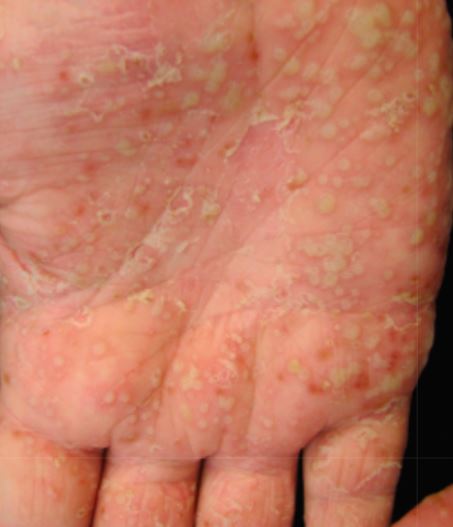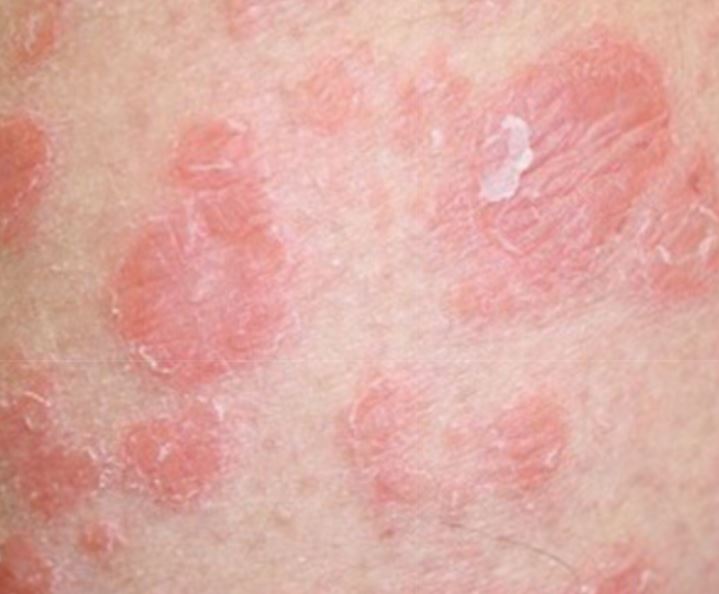Also known as … Chronic Palmoplantar Pustular Psoriasis, Pustulosis palmaris et plantaris, persistent palmoplantar pustulosisWhat is palmoplantar pustulosis?
Palmoplantar pustulosis (PPP) is a chronic pustular condition affecting the palms of the hands and/or soles of the feet. It may occur with psoriasis or without any other skin disease.
The cause of PPP is not completely understood. PPP affects the eccrine sweat glands which are most common on the palms and soles. It may be autoimmune in origin.
Genetic factors are important as several members of some families may be affected.
PPP presents as crops of itchy or sore pustules on the palms and/or soles. PPP can occur on one or both hands and/or feet. Scaly red patches may also be seen in association with the pustules.
In the more chronic stages of the disease, the skin can be dry and thickened with deep fissures (cracks in the skin). There is usually a sharp demarcation between the normal and affected skin areas.
PPP varies in severity and may persist for many years. The discomfort can be considerable, interfering with work and affecting quality of life.
A form of PPP which affects the tips of the fingers is called acrodermatitis continua of Hallopeau or acropustulosis. It can lead to destruction of the fingernail on affected digits.


Certain conditions have been reported to occur in individuals with PPP:
- Autoimmune diseases, particularly gluten sensitive enteropathy (celiac disease), thyroid disease and type 1diabetes
- A minority of affected individuals (10-20%) have chronic plaque psoriasis elsewhere.
- Certain psoriasis treatments called TNF-alpha antagonists have been known to trigger PPP.
- A remote bacterial infection
- More than 90% of individuals with PPP are current or previous smokers.
In most cases, the diagnosis is made by clinical examination. In rare cases, a biopsy may be needed to confirm the diagnosis. Skin scrapings can exclude fungal infections that may mimic PPP. Skin swabs may be taken to exclude a bacterial infection but will be negative in uncomplicated PPP.
Treatment of PPP can be difficult. The condition can also respond poorly to therapy. Less severe cases can usually be managed with topical treatments. More severe cases may require physical or systemic therapy.
General measures
- Stop smoking. This can improve some but not all cases of PPP.
- Use a soap free wash or soap substitute for cleansing and apply thick emollients (such as white soft paraffin) several times a day to help reduce inflammation and dryness.
- Use gloves for wet work, gardening or manual labour.
- Choose socks and shoes made from natural, rather than man-made fibres (cotton rather than nylon).
- Avoid friction and minor injuries.
- Cover deep fissures or cracks with waterproof dressings, emollients or zinc oxide paste.
- Rest affected areas if possible.
- Use salicylic acid ointment or urea cream to reduce thick skin and exfoliate scales.
Topical treatments
- Steroid creams and ointments can reduce inflammation in the skin. They are stronger and more effective when applied under occlusion (i.e. covered with cotton gloves and socks or cling film after application).Long-term side effects of steroids such as skin thinning must be monitored carefully.
- Tar ointments have been used for many decades to moisturise and reduce inflammation. These can be used in combination with steroid ointments to reduce side effects of the latter.
- Topical calcineurin inhibitors (e.g. tacrolimus, pimecrolimus) have also been shown to be effective in some cases.
- Vitamin D creams can improve some cases of PPP.
Light treatment
- Light treatment or phototherapy involves exposing the affected areas to UV light for a specified time period. A number of options have been used for PPP. These include the following:
- Photochemotherapy (the combination of exposure to ultraviolet radiation (UV-A) with psoralens taken as tablets or applied topically)
- Narrowband UVB light
Systemic treatment
Systemic treatments include tablets or injections that require regular monitoring.
- Acitretin is a vitamin A derivative and is a member of a group of drugs called retinoids. Acitretin can be effective in the treatment of PPP. It can be used alone orin combination with creams or phototherapy. Oral retinoids in combination with phototherapy can work together to shorten the course of treatment.
- Methotrexate and cyclosporine can modify the immune response of the body. However, these medications are not first line treatments.
- Other tablets e.g. dapsone, colchicine and tetracyclines can be effective in exceptional cases.
- Biologic treatment such as adalimumab can be effective in recalcitrant cases of PPP.
This information has been written by Dr Davin Lim and Dr Heba Jibreal
Disclaimer
2019 © Australasian College of Dermatologists.
You may use for personal use only. Please refer to our disclaimer.